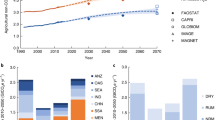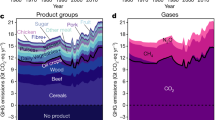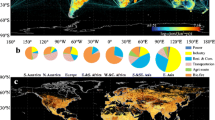Abstract
Mitigation of climate change requires the systematic identification and cataloging of emissions sources at city, state, and national levels. In this study, an inventory of annual greenhouse gas emissions from the state of Nebraska was created based on industry data, and emissions inventories were completed each year from 1990 to 2016. Nebraska’s net emissions were found to increase from 56.2 million metric tons of carbon dioxide equivalents (MMtCO2e) in 1990 to 87.4 MMtCO2e in 2016. Agriculture was found to be the sector with the most emissions (36 MMtCO2e) followed by electricity generation (21 MMtCO2e). In 2016, emissions from beef cattle made up 55% of agricultural emissions and 23.7% of net state emissions; if all beef were substituted with pork, net state emissions could be reduced by 17.9%. Coal for electricity had the largest increase in emissions from 1990 to 2016 (7.4 MMtCO2e) and made up 23.7% of the state’s net emissions in 2016. Net emissions per capita in Nebraska were found to be 46.2 metric tons CO2e per capita (MtCO2e) in 2015, which is more than double US average emissions at 18.4 MtCO2e, though potentially similar to those of other agricultural states when emissions from agriculture are included in state inventories.
Access this chapter
Tax calculation will be finalised at checkout
Purchases are for personal use only
Similar content being viewed by others
References
Beauchemin KA, McGinn SM (2008) Reducing methane in dairy and beef cattle operations: what is feasible. Prairie Soil Crop 1:17–21
Carattini S, Carvalho M, Fankhauser S (2018) Overcoming public resistance to carbon taxes. Wiley Interdiscip Rev Clim Change 9(5):e531
Carattini S, Kallbekken S, Orlov A (2019) How to win public support for a global carbon tax. Nature 565:289–291
Coniff R (2018) The case for a carbon tax on beef. The New York Times. March 17
Database of State Incentives for Renewables & Efficiency (DSIRE) (2019) Detailed summary maps
Davis SJ, Lewis NS, Shaner M, Aggarwal S, Arent D, Azevedo IL et al (2018) Net-zero emissions energy systems. Science 360(6396)
de Vries M, de Boer IJ (2010) Comparing environmental impacts for livestock products: a review of life cycle assessments. Livestock Sci 128(1–3):1–11
Department of Ecology State of Washington (DEWA) (2018) Washington state greenhouse gas emissions inventory: 1990-2015 report to the legislature. Lacey, WA
Department of Environmental Conservation Air Quality and Climate Division State of Vermont (DECV) (2018) Greenhouse gas emissions inventory update: brief 1990-2015. Montpelier, VT
Department of Environmental Protection State of Maine (DEPM) (2019) Reducing greenhouse gas emissions. Augusta, ME
Department of Environmental Protection State of New Jersey (DEPNJ) (2017) 2015 statewide greenhouse gas emissions inventory. Trenton, NJ
Department of Environmental Quality State of Oregon (DEQO) (2018) Oregon’s greenhouse gas emissions: 1990-2016 prepared for the Oregon office of carbon policy. Portland, OR
Department of Transportation (DOT) (2018) Distribution, transmission, and liquid annual data 1990-2016. Washington, DC
EIA (2014) Annual energy outlook 2014: implications of low electricity demand growth. Washington, DC
EIA (2018a) Detailed state electricity data. Washington, DC
EIA (2018b) Nebraska state profile and energy estimates. Washington, DC
EIA (2018c) Detailed state data. Washington, DC
EIA (2019a) Petroleum sales and consumption: fuel oil and kerosene sales. Washington, DC
EIA (2019b) How much electricity is lost in electricity transmissions and distribution in the United States? Washington, DC
EPA (2019) Inventory of U.S. Greenhouse gas emissions and sinks: 1990-2017. Washington, DC
Eshel G, Shepon A, Makov T, Milo R (2014) Land, irrigation water, greenhouse gas, and reactive nitrogen burdens of meat, eggs, and dairy production in the United States. Proceedings of the National Academy of Sciences 111(33):11996–12001
Fargione J, Hill J, Tilman D, Polasky S, Hawthorne P (2008) Land clearing and the biofuel carbon debt. Science 319(5867):1235–1238
Federal Highway Administration (FHWA) (2019) Highway statistics series. Washington, DC
Figueres C, Schellnhuber HJ, Rockstrom J, Hobley A, Rahmstorf S (2017) Three years to safeguard our climate. Nature 546:593–595
Gerber PJ, Steinfeld H, Henderson B, Mottet A, Opio C, Dijkman J et al (2013) Tackling climate change through Livestock – a global assessment of emissions and mitigation opportunities. Food and Agriculture Organization of the United Nations (FAO), Rome
González AD, Frostell B, Carlsson-Kanyama A (2011) Protein efficiency per unit energy and per unit greenhouse gas emissions: potential contribution of diet choices to climate change mitigation. Food Policy 36(5):562–570
Hansen J, Sato M, Kharecha P, Von Schuckmann K, Beerling DJ, Cao J et al (2017) Young people’s burden: requirement of negative CO2 emissions. Earth Syst Dyn 8:577–616
High-Level Commission on Carbon Prices (HLCCP) (2017) Report of the high-level commission on carbon prices. World Bank, Washington, DC
Hoekstra AY, Mekonnen MM (2012) The water footprint of humanity. Proc Natl Acad Sci 109(9):3232–3237
ICF (2018) 2015 Chicago regional greenhouse gas emissions inventory. Fairfax, VA
ICF Consulting (2004). Emissions Inventory Improvement Program (EIIP) Volume VIII: greenhouse gases. Prepared for the U.S. Environmental Protection and STAPPA/ALAPCO, Washington DC.
IEA (2016) CO2 emissions from fuel combustion. Paris, France
Iowa Department of Natural Resources (DNR) (2018) 2017 Iowa statewide greenhouse gas emissions inventory report. Des Moines, IA
IPCC (2006) 2006 IPCC Guidelines for National Greenhouse Gas Inventories. The National Greenhouse Gas Inventories Programme, The Intergovernmental Panel on Climate Change (eds. Eggleston HS, Buendia L, Miwa K, Ngara T, Tanabe K). Hayama, Kanagawa, Japan
IPCC (2019) Climate Change and Land: an IPCC special report on climate change, desertification, land degradation, sustainable land management, food security, and greenhouse gas fluxes in terrestrial ecosystems. Geneva, Switzerland
Joshi DR, Ulrich-Schad J, Wang T, Dunn BH, Clay SA, Bruggeman SA, Clay DE (2019) Grassland retention in the North America Midwest after periods of high commodity prices and climate variability. Soil Sci Soc Am J 83(5):1290–1298
Lee J (2018) Ingredion to spend millions of dollars on plant-based South Sioux City plant. Sioux City Journal, Sioux City, IA.
Liska AJ, Perrin RK (2011) Energy and climate implications for agricultural nutrient use efficiency. In: Clay DE, Shanahan JF (eds) GIS applications in agriculture, volume two: nutrient management for energy efficiency. CRC Press, Boca Raton, pp 1–17
Lovins A (2013) Reinventing fire: bold business solutions for the new energy era. Chelsea Green Publishing, Hartford, VT
Millar RJ, Fuglestvedt JS, Friedlingstein P, Grubb M, Rogelj J, Matthews HD et al (2017) Emission budgets and pathways consistent with limiting warming to 1.5°C. Nat Geosci 10:741–747
Morton O (2016) The planet remade: how geoengineering could change the world. Princeton University Press, Princeton, NJ
NDA (2019) Nebraska agriculture fact card. Lincoln, NE
NEO (2018a) Population by age, nebraska. Lincoln, NE
NEO (2018b) Annual report 2017. Lincoln, NE
NEO (2018c) Motor vehicle miles traveled in Nebraska. Lincoln, NE
NEO (2018d) Nebraska motor vehicle registrations. Lincoln, NE
NEO (2019a) Electricity consumption in Nebraska by end–use sector. Lincoln, NE
NEO (2019b) Energy prices in Nebraska’s electric power sector. Lincoln, NE
Pacala S, Socolow R (2004) Stabilization wedges: solving the climate problem for the next 50 years with current technologies. Science 305(5686):968–972
Pelletier N (2008) Environmental performance in the US broiler poultry sector: life cycle energy use and greenhouse gas, ozone depleting, acidifying and eutrophying emissions. Agric Syst 98(2):67–73
Pelletier N, Pirog R, Rasmussen R (2010a) Comparative life cycle environmental impacts of three beef production strategies in the Upper Midwestern United States. Agric Syst 103(6):380–389
Pelletier N, Lammers P, Stender D, Pirog R (2010b) Life cycle assessment of high-and low-profitability commodity and deep-bedded niche swine production systems in the Upper Midwestern United States. Agric Syst 103(9):599–608
Phetteplace HW, Johnson DE, Seidl AF (2001) Greenhouse gas emissions from simulated beef and dairy livestock systems in the United States. Nutr Cycling Agroecosyst 60(1):99–102
Poore J, Nemecek T (2019) Reducing food’s environmental impacts through producers and consumers. Science 360(6392):987–992
Tollefson J (2018) Can the world kick its fossil-fuel addiction fast enough? Nature 556:422–425
United Nations Environmental Program (UNEP) (2017) The Emissions Gap Report 2017. Nairobi, Kenya
United Nations Population Division (UNPD) (2018) World population prospects 2017. New York, NY.
United States Census Bureau (2018) 2018 population estimates. Washington, DC
United States Global Climate Research Program (USGCRP) (2018) Impacts, risks, and adaptation in the united states: fourth national climate assessment, Volume II (eds. Reidmiller DR, Avery CW, Easterling DR, Kunkel KE, Lewis KLM, Maycock TK, Stewart BC). US Global Change Research Program, Washington, DC, 1515 pp
University of Hawaii Economic Research Organization (UHERO) and ICF (2019) Hawaii greenhouse gas emissions report for 2015. Fairfax, VA
USDA ERS (2012) Irrigation & water use. Washington, DC
USDA ERS (2019) Cash receipts by commodity. Washington, DC
USDA NASS (2019) 2018 State agriculture overview: Nebraska. Washington, DC
USDA National Agricultural Statistics Service (NASS) (2018) Quick stats. Washington, DC
World Bank and Ecofys (2018) State and trends of carbon pricing 2018 (May), by World Bank, Washington, DC
World Resources Institute (2018) Climate watch. Washington, D.C.
Wright CK, Wimberly MC (2013) Recent land use change in the Western Corn Belt threatens grasslands and wetlands. Proc Natl Acad Sci 110(10):4134–4413
Xu Y, Ramanathan V (2017) Well below 2°C: mitigation strategies for avoiding dangerous to catastrophic climate changes. Proc Natl Acad Sci 114:10315–10323
Yumashev D, Hope C, Schaefer K, Riemann-Campe K, Iglesias-Suarez F, Jafarov E et al (2019) Climate policy implications of nonlinear decline of Arctic land permafrost and sea ice. Nat Commun 10(1900)
Acknowledgments
The authors thank Katie Torpy, Calvin Harman, Richard Perrin, Rick Stowell, David Aiken, Michael Hayes, Joe Stansberry, and Marnie Stein.
Author information
Authors and Affiliations
Corresponding author
Editor information
Editors and Affiliations
Rights and permissions
Copyright information
© 2022 Springer Nature Switzerland AG
About this chapter
Cite this chapter
Holley, E.R., Liska, A.J. (2022). A Greenhouse Gas Emissions Inventory for Nebraska: Livestock and Coal Loom Large. In: Ray, C., Muddu, S., Sharma, S. (eds) Food, Energy, and Water Nexus. Springer, Cham. https://doi.org/10.1007/978-3-030-85728-8_3
Download citation
DOI: https://doi.org/10.1007/978-3-030-85728-8_3
Published:
Publisher Name: Springer, Cham
Print ISBN: 978-3-030-85727-1
Online ISBN: 978-3-030-85728-8
eBook Packages: Earth and Environmental ScienceEarth and Environmental Science (R0)




